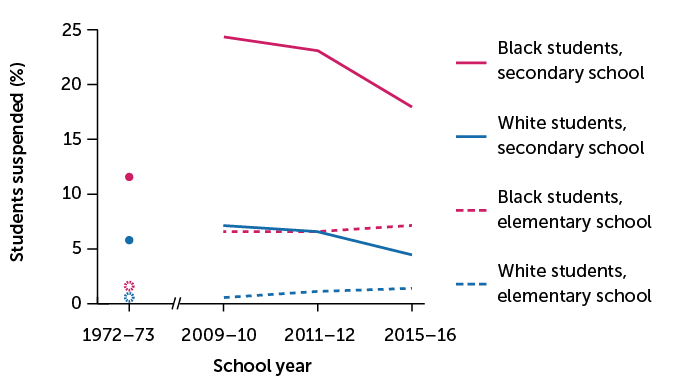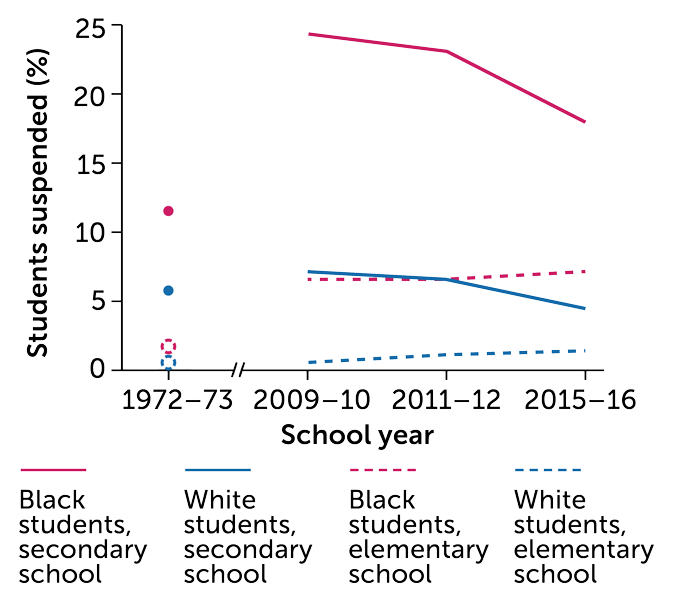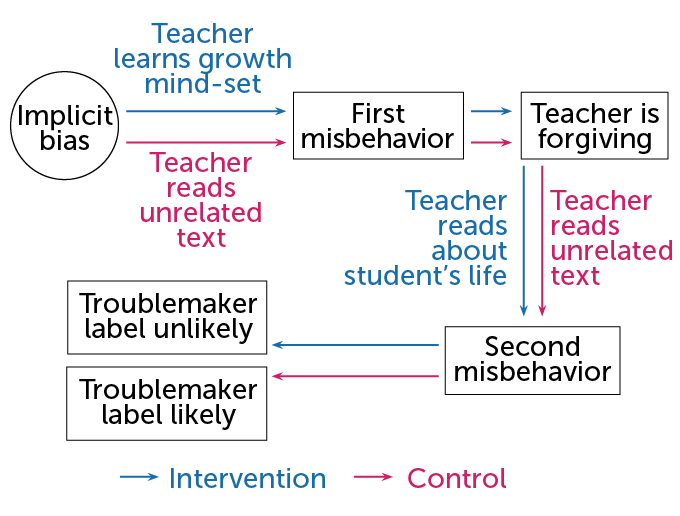This post was originally published on this site
Anne Gregory remembers the child’s fondness for the Dewey decimal system. He would write down a combination of numbers and letters on a scrap of paper and hunt down the desired book in the library. Details were his thing. He once wrote several pages outlining the sequence of moves needed to beat a video game, she says.
But at the elementary school where Gregory worked as a counselor, educators saw a different child. A troublemaker. One teacher told Gregory that the boy frequently wandered about mid-lesson. So the teacher moved his desk to the far corner of the room, and sometimes sent him to the principal’s office.
Outside the principal’s door, the boy joined a queue of almost all Black boys. But Black and Latino students together made up just over half of the school’s student population. Gregory brought up her concerns with the principal. Why was that little boy always in trouble? Why did that line of supposed troublemakers skew Black and male?
This was the mid-1990s, a time when educators and researchers knew Black students, on average, scored lower on standardized tests than white students. This “achievement gap” was, by then, a cause for concern. But how educators treated Black children was rarely part of the discussions. The principal told Gregory that her concerns, while potentially valid, were “too hot” to tackle.
“I could just see how much the school structure itself was squelching this African-American boy’s potential and all his strengths,” Gregory says. “That, accompanied with the silence around this at his school, demonstrated to me the absolute urgency, the need, to point this out.”
Gregory, now a psychologist at Rutgers University in Piscataway, N.J., has devoted her career to pointing out the problem. In the January 2010 Educational Researcher, she and colleagues used the term “discipline gap” to characterize what she’d observed: Black students, particularly boys, were punished more frequently and severely than their white peers — despite a lack of evidence that the Black kids were committing more offenses. Those punishments ranged from teachers sending students to the principal’s office to expulsion. Black students’ disproportionate removal from school may well underlie the achievement gap, Gregory and others contend.
I could just see how much the school structure itself was squelching this African American boy’s potential and all his strengths.
Anne Gregory
In 2015, President Barack Obama signed into law the Every Student Succeeds Act, in part to curtail practices that pull students from class. The act required each state to collect and report data on discipline, and school districts had to formulate alternatives to suspensions and expulsions. A handful of states and districts have banned suspensions for minor offenses, such as talking back to a teacher.
But President Donald Trump’s administration rolled back key requirements. And as of July 2020, no states were fully reporting disciplinary data, according to an October 11 report by the Civil Rights Project, a UCLA group that promotes social justice research. In addition, Black students in middle and high school were four times as likely to be suspended as white students, based on federal data from the 2015–16 academic year.
Policy changes alone cannot close the gap, says Russell Skiba, a psychologist at Indiana University Bloomington who focuses on equity in education. Educators must also transform how they view Black students. “What we need are interventions that look at both a reduction in overall use of exclusionary discipline, but also focus on issues of implicit bias [and] structural racism,” Skiba says.
Removing Black students from the classroom robs them of a lifetime of opportunity, adds Daniel Losen, director of UCLA’s Center for Civil Rights Remedies and a coauthor of the October report. Compared with other students, punished students are more likely to fall behind academically, often by years, have lower test scores, drop out of school, earn less and end up in prison. “This is a massive civil rights violation,” Losen says.
Punishing customs
Punitive practices in U.S. schools are nothing new. Teachers commonly paddled or whipped students into the early 1900s. Corporal, or physical, punishment remains legal in many states to this day. By the 1960s, teachers and other educational leaders also began suspending students for misbehavior.
Harsh discipline in all forms was falling out of favor until the crack cocaine epidemic began ravaging Black communities in the 1980s. Politicians launched “a war on drugs” to wipe out that scourge. Violent crime also peaked in the early 1990s. Those twin forces led to policy changes in the 1980s and ’90s that made prison sentences for drug and violent crimes harsher, including mandatory minimum sentences for certain offenses. At the time, people believed that criminals thrive in chaotic, lawless environments, Losen says. So law enforcement began giving citations for even minor violations.
Those draconian practices reached the classroom. President Bill Clinton signed the Gun-Free Schools Act of 1994 mandating expulsion for a minimum of one year of any student who brought a weapon to school, no hearing necessary. States soon passed zero-tolerance laws that led to suspensions or expulsions for even minor offenses. Students have been removed from school for wielding “weapons,” such as nail clippers or rubber bands, or distributing “contraband” cough drops. Today, zero-tolerance policies account for about 10 percent of the racial discipline gap, educational policy expert Chris Curran of the University of Florida in Gainesville reported in the December 2016 Educational Evaluation and Policy Analysis.
Compared with other students, punished students are more likely to fall behind academically, often by years, have lower test scores, drop out of school, earn less and end up in prison.
Educators’ explicit or implicit biases against Black children also keep the gap wide, research suggests. Those biases are present even in preschools. In one study, researchers fit 132 early education teachers with eye trackers and asked the teachers to watch video clips of four children — a Black girl, a Black boy, a white girl and a white boy — seated around a table. The researchers told the teachers to look for misbehaviors.
In truth, none of the children misbehaved, but the eye trackers revealed that the teachers spent more time gazing at the Black boy. And in an accompanying questionnaire that asked which child required the most attention, 42 percent of respondents chose the Black boy, 34 percent chose the white boy, 13 percent chose the white girl and 10 percent chose the Black girl, researchers from Yale University wrote in a report to federal and state officials in September 2016.
Another study shows how such biases contribute to teachers disciplining Black students more harshly than white students. Researchers asked 191 teachers of K–12 students to imagine teaching at a middle school depicted in a photograph. The teachers then read a series of vignettes about a student who got in trouble twice, once for insubordination and again for disrupting class. Researchers told half the teachers that the student’s name was Darnell or Deshawn, stereotypically Black male names; for the other half, the boy was named Greg or Jake, stereotypically white male names.
After each incident, the teachers answered questions on a seven-point scale. Questions included, “How severe was the student’s misbehavior?” and “How severely should the student be disciplined?” After the first bad behavior, the teachers were equally lenient toward the Black and white boys. But after the second bad behavior, the teachers rated Black boys as 25 percent more troublesome than white boys and recommended 30 percent harsher disciplinary responses, reported social psychologists Jason Okonofua and Jennifer L. Eberhardt of Stanford University in 2015 in Psychological Science. The researchers called this finding the “two-strikes” paradigm.
That study shows how bias can manifest in institutions, says Sean Darling-Hammond, a graduate student in education policy at the University of California, Berkeley, who collaborates with Okonofua, also now at UC Berkeley, to continue that line of research. After repeated misbehaviors, teachers were more lenient with white students, but penalized Black students.
Color-blind corrections
The October report provides the most up-to-date snapshot of the discipline gap. Data for the report come from the U.S. Department of Education Civil Rights Data Collection and include information on student enrollment, demographics and discipline for every public school in the country.
Overall suspension rates were declining under the Obama administration, probably in part because 15 states adopted laws discouraging suspensions. California, for instance, flags districts that suspend more than 6 percent of their students and assists in bringing those districts’ rates down.
When grades K–12 were lumped together, suspension rates fell from 4 percent to 3 percent for white students and 16 percent to 13 percent for Black students, between the 2009–10 to 2015–16 school years.
But with Black students still suspended at four times the rate of white students, the report also spotlights the shortcomings of relying solely on policy changes to close the gap. No policy can capture the myriad interactions that happen in a school, says educational policy researcher Kenneth Shores of the University of Delaware in Newark. Consider common scenarios — teachers praising white students while criticizing Black students, or calling mostly on white students.
Yet many current interventions aim to improve school climate while sidestepping issues of race. For instance, several programs rely on restorative justice. That concept is applied frequently in criminal justice settings, and brings victims and offenders together to discuss an incident and give all involved parties a voice.
Restorative justice practices can help teachers change how they handle discipline problems. Such approaches can also create school cultures based on trust and open communication, often in lieu of discipline. For instance, many schools use a multitiered system of support for students and staff. Tier one is preventive: Students come together in so-called community-building circles to discuss a prompt or question and listen to one another’s perspectives. At tier two, students involved in a minor dispute work together in “responsive circles” to solve the problem. And at tier three, everyone involved in a serious dispute participates in a “restorative conference” where a trained facilitator guides the dialog. If a student is still suspended, educators later welcome the student back to school and gauge his or her need for additional support to get caught up.
In 2006, the suspension gap between Black and white students in the large urban district of Denver was 12 percentage points: About 6 percent of white students had been suspended compared with 18 percent of Black students. By 2013, the gap had narrowed to 8 percentage points, researchers reported in Closing the School Discipline Gap, a 2015 book Losen coedited. Some of the drop may have been due to restorative justice training, which launched in the early 2000s.
Nonetheless, educators were still suspending more Black students — at a rate of 10.42 percent versus 2.28 percent for white students. In effect, the color-blind approach worsened the racial suspension gap from a threefold difference between Black and white students to more than fivefold.
“Interventions for reducing disparities in … discipline cannot be race neutral,” says Indiana’s Skiba.
Addressing race
Decades have passed since Gregory observed that elementary school boy waiting outside the principal’s office. Yet she is still grappling with how to help children like him.
Two years ago, for instance, Gregory and her colleagues piloted a program at one elementary, one middle and one high school in New York City to confront racism in schools. That program combines a race-conscious version of restorative justice with socioemotional learning. The latter helps children regulate their emotions by teaching self- and social awareness and responsible decision making. During 25 hours of training, teachers come together in circles similar to those used in Denver. The prompt, however, asks teachers to consider how structural racism hurts children. After that initial training, coaches also work with the teachers one-on-one.
This facilitated dialog around race has helped teachers speak freely about their worries, Gregory noted in 2018 in the trade publication The Learning Professional. For instance, during the training circles, teachers often express concern that nonpunitive approaches are too soft or unstructured. When that happens, Gregory and her colleagues walk teachers through scenarios of alternative responses to students misbehaving.
Data collection is also key to the success of a new program, Gregory says. Crunching the numbers can illuminate disparities that might otherwise go unnoticed. For example, the pilot middle school in Gregory’s study had a predominantly Black student population, making racial gaps in discipline less of a problem to begin with. School officials knew, however, that girls there had more behavioral problems than boys. Yet an examination of discipline data showed that teachers were punishing boys more frequently and more severely than girls.
In 2019, the team began scaling up the program to eventually reach 18 schools in Queens and Brooklyn. The researchers are also monitoring how school leaders are providing support, such as space for restorative circles and freeing up time for students to learn socioemotional skills. The pandemic, however, interrupted the expansion effort and the release of preliminary results, Gregory says.
But research in education and other fields shows that efforts to eradicate people’s biases rarely stick. So rather than targeting the bias itself, Darling-Hammond, Okonofua and UC Berkeley psychology graduate student Amanda Perez recently tried addressing its downstream consequences. That is, if harsh discipline is seen as the culmination of a process that begins with bias and ends with, say, expulsion, then what targets between those two points might be easier to change? The team identified activities that changed teachers’ thinking or helped them understand a misbehaving student’s perspective.
The two-strikes work from 2015 showed that educators were quick to label Black students as troublemakers. So the trio wondered if teachers could be convinced to adopt a “growth mind-set” — the belief that students and relationships could change. The team also theorized that once teachers adopted a growth mind-set, they would need time and space to get to know their students.
Okonofua and colleagues knew from the 2015 study that teachers recommended 30 percent harsher discipline for Black students than white students. So in a follow-up study, the team asked a different group of U.S. teachers to read vignettes about hypothetical students named Deshawn or Greg.
But this time teachers had extra vignettes to read. First, about half of the 243 teachers read a passage on the growth mind-set, specifically how teachers can change a student’s life. Second, the teachers read about how their relationship to students could grow. Third, they read about the student’s initial misbehavior. Fourth, they read about the student’s love of music and struggles outside school. And finally, the teachers read about the student’s second misbehavior, then answered a set of questions.
Teachers in a control group, meanwhile, read only the misbehavior vignettes interspersed with unrelated or subversive readings, such as a passage on how relationships cannot change.
The intervention made responses to both Black and white students more positive. Compared with teachers in the control groups, those who read the additional vignettes about Deshawn were less likely to label him as a troublemaker or expect him to get suspended in the future, and were more likely to feel they could build a strong relationship with him, the team reported October 16 in Science Advances. Though those teachers were also less willing to see Deshawn receive harsh discipline, that finding did not reach statistical significance. Darling-Hammond now hopes to see these interventions tested outside of the lab.
The virtual classroom
Meanwhile, Losen and others worry that the ongoing COVID-19 pandemic could make shrinking the discipline gap even harder. Data collected during the pandemic are not yet available, but anecdotes of teachers punishing Black students for misbehaving during online classes have recently surfaced. Police arrived at the home of a 12-year-old in Colorado after his art teacher saw him playing with a neon green toy gun. The school later suspended the boy for five days. Police also visited a boy in New Jersey after a teacher saw him playing with a Nerf gun. School officials in Louisiana suspended a 9-year-old boy for having an unloaded BB gun visible in his bedroom.
During this pandemic, teachers have even less time and space to get to know what’s going on in their students’ lives. And everyone’s stress levels are at an all-time high, Losen says. “Unless we do something very different and really address needs in a way that we never have, we’re going to see a train wreck.”




